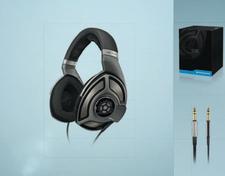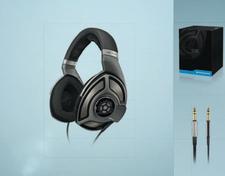

Sennheiser is probably one of the better-known headphone designers in the marketplace today. The company was founded in 1945 and is based in Germany, with manufacturing plants in Germany, Ireland and the United States. The HD 700 over-the-ear headphones are second in command in Sennheiser's audiophile-oriented, full-size headphone category, with the HD 800 taking the lead position. The HD 700 retails for $849.95 on Sennheiser's website. This particular product was designed and engineered in Germany and manufactured in the Ireland facility.
The HD 700 is intended to be a dedicated, high-end, home-use headphone. As such, it doesn't fold, there is no active noise cancellation or smartphone functionality, and it's not designed to take the abuse of traveling. The earphone cup is made up of three large steel mesh panels that surround the open-air dynamic driver, which allows the earphones to breathe, controls sound, and minimizes turbulence within the driver. Impedance is rated at 150 ohms. The HD 700 is made of high-quality plastics, metal, and fabric. It is exquisitely manufactured, yet has a fragile demeanor. The included cables are silver-plated OFC (oxygen-free copper), three meters in length, with an outer cover of high-quality fabric. The cable can be detached from the main headphone unit and has a standard 0.25-inch (6.3mm) connector. A storage box is included.
Additional Resources
 The HD 700 is exceptionally comfortable. Despite its large size, you could wear these headphones for hours without fatigue ... or even forget you have them on, like I did. The ear cups have microfiber fabric circular pads, which surround your ear. The tension of the headband is perfect and has its own microfiber pad. The HD 700 is among the most comfortable headphones I have ever auditioned. Comfort and fit should not be overlooked in a headphone because, regardless of how great a particular product may sound, if it's not comfortable, I doubt you would actually use it.
The HD 700 is exceptionally comfortable. Despite its large size, you could wear these headphones for hours without fatigue ... or even forget you have them on, like I did. The ear cups have microfiber fabric circular pads, which surround your ear. The tension of the headband is perfect and has its own microfiber pad. The HD 700 is among the most comfortable headphones I have ever auditioned. Comfort and fit should not be overlooked in a headphone because, regardless of how great a particular product may sound, if it's not comfortable, I doubt you would actually use it.
I auditioned the HD 700 using an Oppo BDP-95 to spin the discs. In this setup, I used both the analog outputs to power a Grado headphone amplifier and the HDMI output to connect to a Marantz AV8801 A/V processor, to utilize its headphone jack. With "Latin Quarter" by Marc Antoine (The Very Best of Marc Antoine, GRP Records, 2003), the sound was involving, expressive, and large. Balance between upper, midrange, and bass frequencies was excellent, with no fatiguing quality whatsoever, and the sound was very detailed. Imaging is fantastic in width and depth.
I moved on to "Crash" by Dave Matthews Band (Crash, RCA 1996) and again experienced the same high fidelity. However, I noticed a few instances where I could sense an ever-so-slight smearing on specific upper frequencies and "s" sounds but, over time, they disappeared, indicating the need for a proper break-in period. I was able to easily toggle between both the Grado and Marantz setups, and in all cases, the Grado amplifier gave the best performance, providing a more effortless sound quality with greater dynamics and separation between instruments. The HD 700 definitely benefits from a proper headphone amplifier.
Click on over to Page 2 for the High Points, the Low Points, Comparison and Competition and the Conclusion . . .
Low Points
The HE-500 headphone by Hifiman should be considered here. It has a similar price point and, while I have never auditioned those headphones over an extended timeframe, I did get a chance to hear them for a short demo, which was memorable. Also, some investigation indicated that the HE-500 would be a bit more demanding to drive in comparison with the HD 700.
The V-Moda Crossfade M-100 was easily accessible from a recent review I did. Since the time of my review of those headphones, V-Moda sent upgraded, gel-insulated ear pads, which did improve the fit substantially. However, even with the benefit of the gel ear pads, the M-100 was still not as comfortable as the HD 700. To be fair, the V-Moda headphones are intended to be DJ headphones, with some passive noise isolation, while the Sennheiser's intended use is in a dedicated home rig. They also fall into different price categories. The HD 700 has a larger, more dynamic, detailed, and expressive quality, while the V-Moda has more pronounced bass, but to a fault.
Lastly, the HD 700 seems closer to the Grado "house sound" than that of most other Sennheisers. I have a pair of old Grado RS-1s that have a more forward sound than most of the Sennheiser HD Series headphones I have listened to in the past but, of all those HD Series headphones, the HD 700 comes closest to the Grado's sound quality.
Conclusion
Owning high-end dedicated headphones really can be convenient - if they are the right ones. During my time with the Sennheiser HD 700, I found myself utilizing the headphones in ways that I have never used headphones in the past. There were a few occasions where I did not have access to my main stereo due to sleeping family members. Typically, that would kill the mood to do any sort of critical listening, but I found myself drawn to the Sennheisers and actually used them in these situations. In addition, on a few sleepless nights (when the rest of the family was sleeping), I found myself thinking, "I could listen to some music on the Sennheisers." And I did ... which is interesting, because that is an option I've never entertained prior to my time with the HD 700. For me, that says it all.
Additional Resources